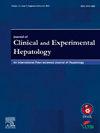Lifestyle Intervention is Effective in Reversal of Fibrosis in NAFLD Patients: Results from a Retrospective Real-World Study
IF 3.2
Q2 GASTROENTEROLOGY & HEPATOLOGY
Journal of Clinical and Experimental Hepatology
Pub Date : 2025-05-22
DOI:10.1016/j.jceh.2025.102598
引用次数: 0
Abstract
Background
Nonalcoholic fatty liver disease (NAFLD) is a lifestyle disorder, and lifestyle intervention (LI) remains the cornerstone of NAFLD management. Despite this, in recent years, the focus has been primarily on developing newer drugs and not on LIs, presumably due to a lack of medication adherence. We aimed to investigate the ability of LI to reverse fibrosis in NAFLD patients.
Methods
Seven hundred seventy-six patients were retrospectively included, of which 565 patients were analysed. Anthropometric and biochemical parameters and 2D-SWE measurements of all patients were recorded before and after LI.
Results
Weight reduction was observed in 85.2% of the patients. The mean body mass index (BMI) decreased from 26.08 ± 3.53 kg/m2 to 25.06 ± 3.19 kg/m2 (P < 0.001) in the cohort. The mean waist and hip circumferences decreased significantly from 98.87 ± 8.72 cm to 94.40 ± 7.67 cm and from 103.63 ± 7.91 cm to 101.98 ± 7.17 cm, respectively (P < 0.001). Significant reductions in serum low-density lipoprotein (112.93 ± 33.23 mg/dL to 104.12 ± 31.10 mg/dL, P < 0.001) and very low-density lipoprotein (34.05 ± 19.43 mg/dL to 30.26 ± 12.58 mg/dL, P < 0.001) levels were also observed post-intervention. Decrease in liver stiffness was observed in 67.9% of the patients, and a one-stage reduction in fibrosis was observed in 40.5% of the patients, while a 2-point reduction in liver stiffness was observed in 52% of the patients; reversal of hepatic steatosis occurred in 16.4% of the patients. A significant reduction in liver stiffness was seen post-intervention (7.21 ± 1.84 kPa to 6.61 ± 1.59 kPa, P < 0.001). BMI reduction correlated positively with a decrease in liver stiffness (r = 0.43, P < 0.001).
Conclusion
LI when sustained over a year can improve liver stiffness in NAFLD, even in a real-world setting. However, prospective case–control studies are required to robustly assess the effectiveness, safety with regard to micronutrient deficiency, and long-term outcomes of LI in NAFLD.

生活方式干预在NAFLD患者的纤维化逆转中是有效的:来自回顾性现实世界研究的结果
背景:非酒精性脂肪性肝病(NAFLD)是一种生活方式障碍,生活方式干预(LI)仍然是NAFLD治疗的基石。尽管如此,近年来,人们的注意力主要集中在开发新药上,而不是在LIs上,这可能是由于缺乏药物依从性。我们的目的是研究LI逆转NAFLD患者纤维化的能力。方法回顾性分析776例患者,其中565例进行分析。记录LI前后所有患者的人体测量、生化参数及2D-SWE测量。结果85.2%的患者体重减轻。平均体重指数(BMI)由26.08±3.53 kg/m2降至25.06±3.19 kg/m2 (P <;0.001)。平均腰、臀围分别由98.87±8.72 cm降至94.40±7.67 cm和103.63±7.91 cm降至101.98±7.17 cm (P <;0.001)。血清低密度脂蛋白显著降低(112.93±33.23 mg/dL至104.12±31.10 mg/dL, P <;0.001)和极低密度脂蛋白(34.05±19.43 mg/dL ~ 30.26±12.58 mg/dL, P <;干预后也观察到0.001)的水平。67.9%的患者肝硬度降低,40.5%的患者肝纤维化减轻一期,52%的患者肝硬度减轻2点;16.4%的患者出现肝脂肪变性逆转。干预后肝脏僵硬度显著降低(7.21±1.84 kPa至6.61±1.59 kPa, P <;0.001)。BMI降低与肝脏硬度降低呈正相关(r = 0.43, P <;0.001)。结论:即使在现实环境中,持续1年以上的li也能改善NAFLD患者的肝脏硬度。然而,需要前瞻性病例对照研究来可靠地评估LI在NAFLD中微量营养素缺乏的有效性、安全性和长期结果。
本文章由计算机程序翻译,如有差异,请以英文原文为准。
求助全文
约1分钟内获得全文
求助全文
来源期刊

Journal of Clinical and Experimental Hepatology
GASTROENTEROLOGY & HEPATOLOGY-
CiteScore
4.90
自引率
16.70%
发文量
537
审稿时长
64 days
 求助内容:
求助内容: 应助结果提醒方式:
应助结果提醒方式:


